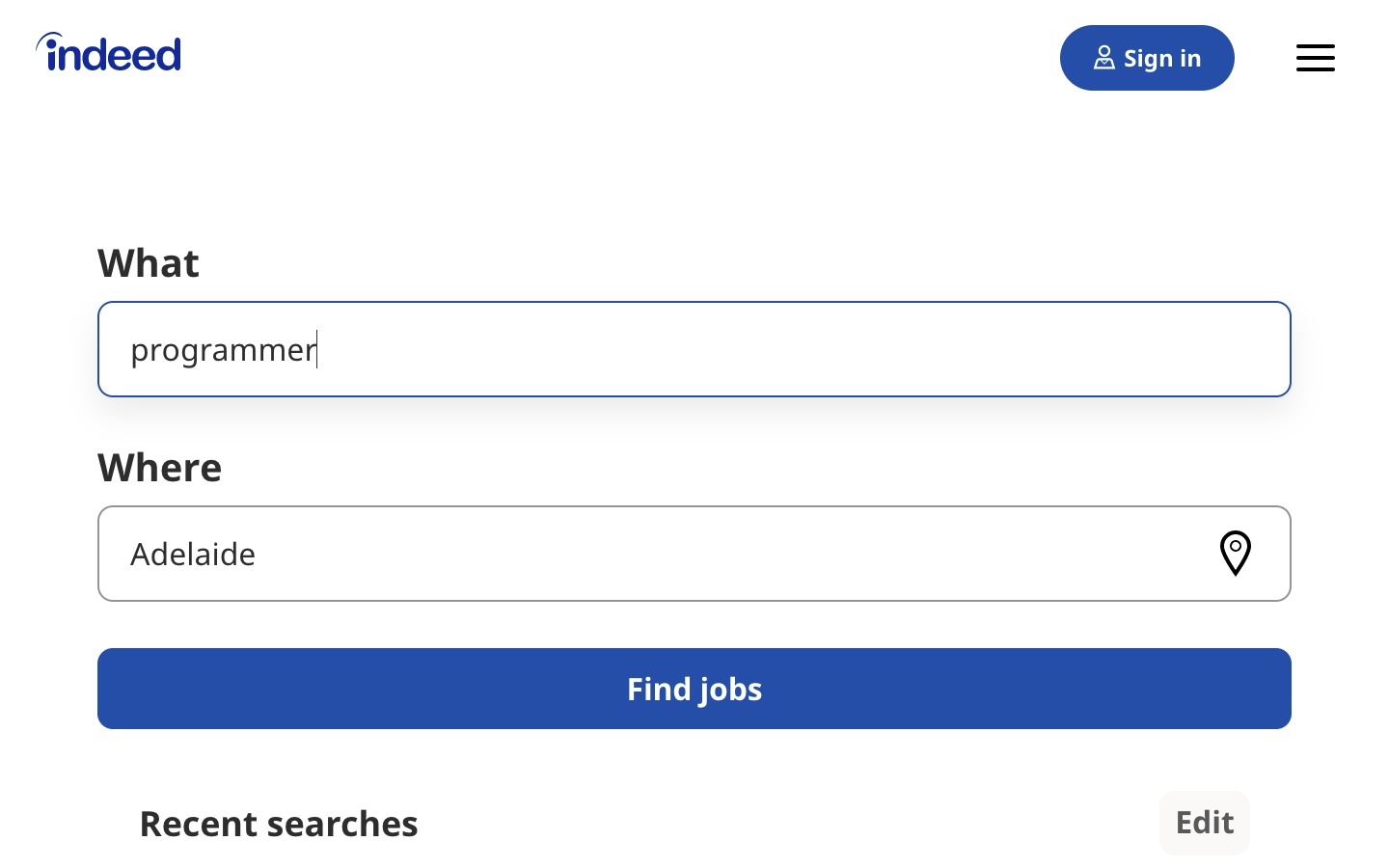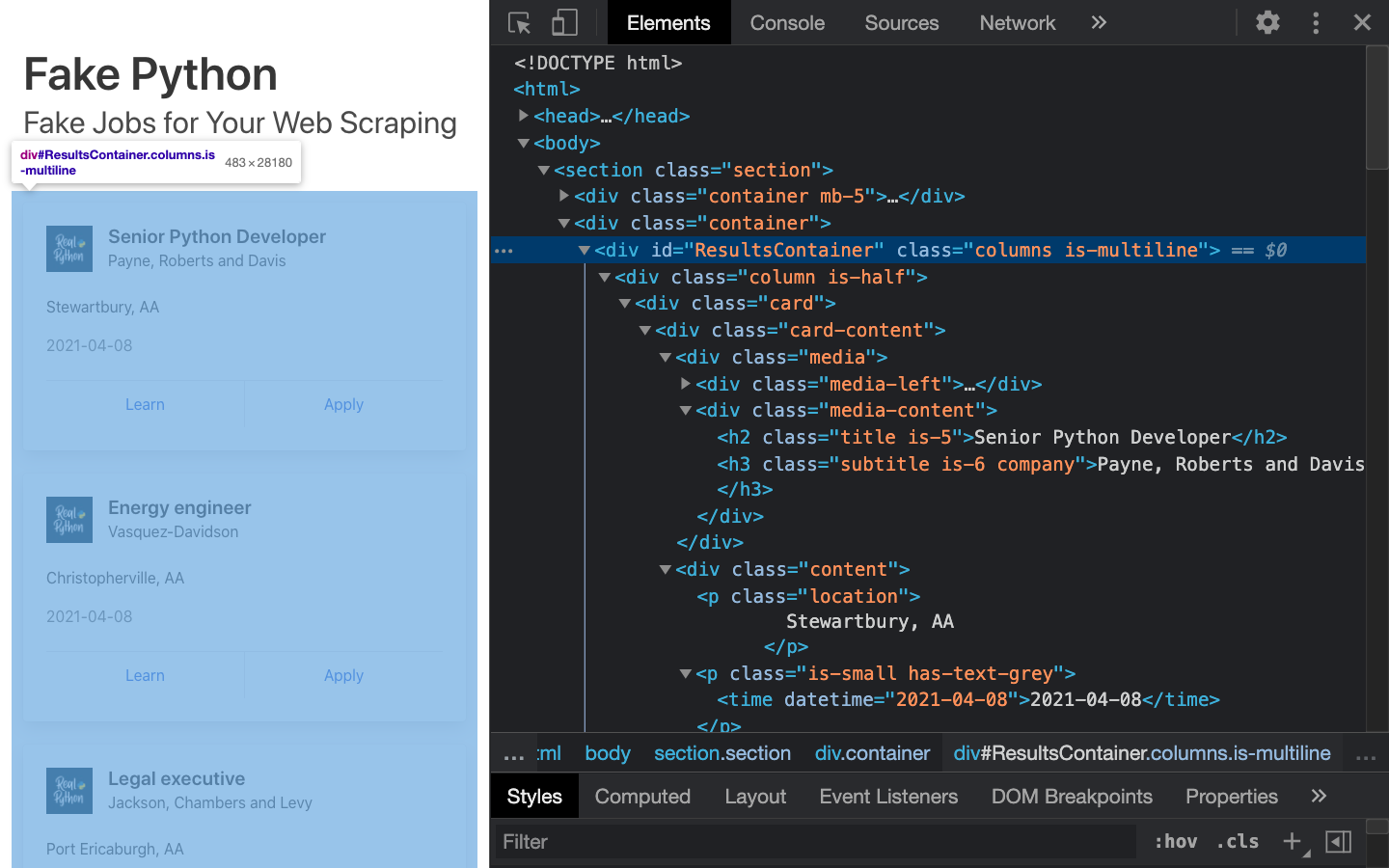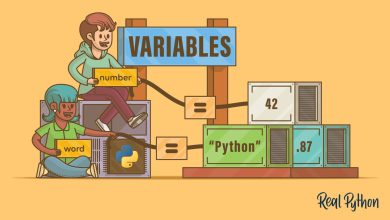Build a Web Scraper With Python – Real Python

Web scraping is the automated process of extracting data from the internet. The Python libraries Requests and Beautiful Soup are powerful tools for the job. To effectively harvest the vast amount of data available online for your research, projects, or personal interests, you’ll need to become skilled at web scraping.
If you like learning with hands-on examples and have a basic understanding of Python and HTML, then this tutorial is for you! Working through this project will give you the knowledge and tools you need to scrape any static website out there on the World Wide Web. You can download the project source code by clicking on the link below:
What Is Web Scraping?
Web scraping is the process of gathering information from the internet. Even copying and pasting the lyrics of your favorite song can be considered a form of web scraping! However, the term “web scraping” usually refers to a process that involves automation. While some websites don’t like it when automatic scrapers gather their data, which can lead to legal issues, others don’t mind it.
If you’re scraping a page respectfully for educational purposes, then you’re unlikely to have any problems. Still, it’s a good idea to do some research on your own to make sure you’re not violating any Terms of Service before you start a large-scale web scraping project.
Reasons for Automated Web Scraping
Say that you like to surf—both in the ocean and online—and you’re looking for employment. It’s clear that you’re not interested in just any job. With a surfer’s mindset, you’re waiting for the perfect opportunity to roll your way!
You know about a job site that offers precisely the kinds of jobs you want. Unfortunately, a new position only pops up once in a blue moon, and the site doesn’t provide an email notification service. You consider checking up on it every day, but that doesn’t sound like the most fun and productive way to spend your time. You’d rather be outside surfing real-life waves!
Thankfully, Python offers a way to apply your surfer’s mindset. Instead of having to check the job site every day, you can use Python to help automate the repetitive parts of your job search. With automated web scraping, you can write the code once, and it’ll get the information that you need many times and from many pages.
Note: In contrast, when you try to get information manually, you might spend a lot of time clicking, scrolling, and searching, especially if you need large amounts of data from websites that are regularly updated with new content. Manual web scraping can take a lot of time and be highly repetitive and error-prone.
There’s so much information on the internet, with new information constantly being added. You’ll probably be interested in some of that data, and much of it is out there for the taking. Whether you’re actually on the job hunt or just want to automatically download all the lyrics of your favorite artist, automated web scraping can help you accomplish your goals.
Challenges of Web Scraping
The internet has grown organically out of many sources. It combines many different technologies, styles, and personalities, and it continues to grow every day. In other words, the internet is a hot mess! Because of this, you’ll run into some challenges when scraping the web:
-
Variety: Every website is different. While you’ll encounter general structures that repeat themselves, each website is unique and will need personal treatment if you want to extract the relevant information.
-
Durability: Websites constantly change. Say you’ve built a shiny new web scraper that automatically cherry-picks what you want from your resource of interest. The first time you run your script, it works flawlessly. But when you run the same script a while later, you run into a discouraging and lengthy stack of tracebacks!
Unstable scripts are a realistic scenario because many websites are in active development. If a site’s structure changes, then your scraper might not be able to navigate the sitemap correctly or find the relevant information. The good news is that changes to websites are often small and incremental, so you’ll likely be able to update your scraper with minimal adjustments.
Still, keep in mind that the internet is dynamic and keeps on changing. Therefore, the scrapers you build will probably require maintenance. You can set up continuous integration to run scraping tests periodically to ensure that your main script doesn’t break without your knowledge.
An Alternative to Web Scraping: APIs
Some website providers offer application programming interfaces (APIs) that allow you to access their data in a predefined manner. With APIs, you can avoid parsing HTML. Instead, you can access the data directly using formats like JSON and XML. HTML is primarily a way to visually present content to users.
When you use an API, the data collection process is generally more stable than it is through web scraping. That’s because developers create APIs to be consumed by programs rather than by human eyes.
The front-end presentation of a site might change often, but a change in the website’s design doesn’t affect its API structure. The structure of an API is usually more permanent, which means it’s a more reliable source of the site’s data.
However, APIs can change as well. The challenges of both variety and durability apply to APIs just as they do to websites. Additionally, it’s much harder to inspect the structure of an API by yourself if the provided documentation lacks quality.
The approach and tools you need to gather information using APIs is outside the scope of this tutorial. To learn more about it, check out API Integration in Python.
Scrape the Fake Python Job Site
In this tutorial, you’ll build a web scraper that fetches Python software developer job listings from a fake Python job site. It’s an example site with fake job postings that you can freely scrape to train your skills. Your web scraper will parse the HTML on the site to pick out the relevant information and filter that content for specific words.
You can scrape any site on the internet that you can look at, but the difficulty of doing so depends on the site. This tutorial offers you an introduction to web scraping to help you understand the overall process. Then, you can apply this same process for every website that you want to scrape.
Note: Real-life job boards may quickly change in structure and availability. To offer you a smooth learning experience, this tutorial focuses on a self-hosted static site that’s guaranteed to stay the same. This gives you a reliable playground to practice the skills that you need for web scraping.
Throughout the tutorial, you’ll also encounter a few exercise blocks. You can click to expand them and challenge yourself by completing the tasks described within.
Step 1: Inspect Your Data Source
Before you write any Python code, you need to get to know the website that you want to scrape. Getting to know the website should be your first step for any web scraping project that you want to tackle. You’ll need to understand the site structure to extract the information relevant for you. Start by opening the site that you want to scrape with your favorite browser.
Explore the Website
Click through the site and interact with it just like any typical job searcher would. For example, you can scroll through the main page of the website:
On that page, you can see many job postings in a card format. Each of them has two buttons. If you click on Learn, then you’ll visit Real Python’s home page. If you click on Apply, then you’ll see a new page that contains more detailed descriptions of the job on that card. You might also notice that the URL in your browser’s address bar changes when you navigate to one of those pages.
Decipher the Information in URLs
You can encode a lot of information in a URL. Becoming familiar with how URLs work and what they’re made of will help you on your web scraping journey. For example, you might find yourself on a details page that has the following URL:
You can deconstruct the above URL into two main parts:
- The base URL points to the main location of the web resource. In the example above, the base URL is
https://realpython.github.io/. - The path to a specific resource location points to a unique job description. In the example above, the path is
fake-jobs/jobs/senior-python-developer-0.html.
Any job posted on this website will share the same base URL. However, the location of the unique resources will be different depending on the job posting that you view. Usually, similar resources on a website will share a similar location, such as the folder structure fake-jobs/jobs/. However, the final part of the path points to a specific resource and will be different for each job posting. In this case, it’s a static HTML file named senior-python-developer-0.html.
URLs can hold more information than just the location of a file. Some websites use query parameters to encode values that you submit when performing a search. You can think of them as query strings that you send to the database to retrieve specific records.
You’ll find query parameters at the end of a URL. For example, if you go to Indeed and search for “software developer” in “Australia” through the site’s search bar, you’ll see that the URL changes to include these values as query parameters:
The query parameters in this URL are ?q=software+developer&l=Australia. Query parameters consist of three parts:
- Start: You can identify the beginning of the query parameters by looking for the question mark (
?). - Information: You’ll find the pieces of information that constitute one query parameter encoded in key-value pairs, where related keys and values are joined together by an equal sign (
key=value). - Separator: You’ll see an ampersand symbol (
&) separating multiple query parameters if there are more than one.
Equipped with this information, you can separate the URL’s query parameters into two key-value pairs:
q=software+developerselects the type of job.l=Australiaselects the location of the job.
Try to change the search parameters and observe how that affects your URL. Go ahead and enter new values in the search bar of the Indeed job board:

Next, try to change the values directly in your URL. See what happens when you paste the following URL into your browser’s address bar:
If you change and submit the values in the website’s search box, then it’ll be directly reflected in the URL’s query parameters and vice versa. If you change either of them, then you’ll see different results on the website.
As you can see, exploring the URLs of a site can give you insight into how to retrieve data from the website’s server.
Head back to Fake Python jobs and continue to explore it. This site is a static website containing hardcoded information. It doesn’t operate on top of a database, which is why you won’t have to work with query parameters in this scraping tutorial.
Inspect the Site Using Developer Tools
Next, you’ll want to learn more about how the data is structured for display. You’ll need to understand the page structure to pick what you want from the HTML response that you’ll collect in one of the upcoming steps.
Developer tools can help you understand the structure of a website. All modern browsers come with developer tools installed. In this section, you’ll learn how to work with the developer tools in Chrome. The process will be very similar on other modern browsers.
In Chrome on macOS, you can open up the developer tools through the menu by selecting View → Developer → Developer Tools. On Windows and Linux, you can access them by clicking the top-right menu button (⋮) and selecting More Tools → Developer Tools. You can also access your developer tools by right-clicking on the page and selecting the Inspect option or using a keyboard shortcut:
- Mac: Cmd+Alt+I
- Windows/Linux: Ctrl+Shift+I
Developer tools allow you to interactively explore the site’s document object model (DOM) to better understand your source. To dig into your page’s DOM, select the Elements tab in developer tools. You’ll see a structure with clickable HTML elements. You can expand, collapse, and even edit elements right in your browser:

You can think of the text displayed in your browser as the HTML structure of the page. If you’re interested, then you can read more about the difference between the DOM and HTML.
When you right-click elements on the page, you can select Inspect to zoom to their location in the DOM. You can also hover over the HTML text on your right and see the corresponding elements light up on the page.
Click to expand the exercise block for a specific task to practice using your developer tools:
Find a single job posting. What HTML element is it wrapped in, and what other HTML elements does it contain?
Play around and explore! The more you get to know the page you’re working with, the easier it’ll be to scrape. But don’t get too overwhelmed with all that HTML text. You’ll use the power of programming to step through this maze and cherry-pick the information that’s relevant to you.
Step 2: Scrape HTML Content From a Page
Now that you have an idea of what you’re working with, it’s time to start using Python. First, you’ll want to get the site’s HTML code into your Python script so that you can interact with it. For this task, you’ll use Python’s Requests library.
Before you install any external package, you’ll need to create a virtual environment for your project. Activate your new virtual environment, then type the following command in your terminal to install the Requests library:
Then open up a new file in your favorite text editor and call it scraper.py. You only need a few lines of code to retrieve the HTML:
When you run this code, it issues an HTTP GET request to the given URL. It retrieves the HTML data that the server sends back and stores that data in a Python object you called page.
If you print the .text attribute of page, then you’ll notice that it looks just like the HTML you inspected earlier with your browser’s developer tools. You’ve successfully fetched the static site content from the internet! You now have access to the site’s HTML from within your Python script.
Static Websites
The website that you’re scraping in this tutorial serves static HTML content. In this scenario, the server that hosts the site sends back HTML documents that already contain all the data a user gets to see.
When you inspected the page with developer tools earlier on, you discovered that a single job posting consists of the following long and messy-looking HTML:
It can be challenging to wrap your head around a long block of HTML code. To make it easier to read, you can use an HTML formatter to clean up the HTML automatically. Good readability can help you better understand the structure of any block of code. While improved HTML formatting may or may not help, it’s always worth a try.
Note: Keep in mind that every website looks different. That’s why it’s necessary to inspect and understand the structure of the site you’re working with before moving forward.
The HTML you’ll encounter will sometimes be confusing. Luckily, the HTML of this job board has descriptive class names on the elements that you’re interested in:
class="title is-5"contains the title of the job posting.class="subtitle is-6 company"contains the name of the company that offers the position.class="location"contains the location where you’d be working.
If you ever get lost in a large pile of HTML, remember that you can always go back to your browser and use the developer tools to further explore the HTML structure interactively.
By now, you’ve successfully harnessed the power and user-friendly design of Python’s Requests library. With only a few lines of code, you managed to scrape static HTML content from the web and make it available for further processing.
While this was a breeze, you may encounter more challenging situations when working on your own web scraping projects. Before you learn how to select the relevant information from the HTML that you just scraped, you’ll take a quick look at two more challenging situations.
Login-Protected Websites
Some pages contain information that’s hidden behind a login. This means you’ll need an account to be able to scrape anything from the page. Just like you need to log in on your browser when you want to access content on such a page, you’ll also need to log in from your Python script.
The Requests library comes with the built-in capacity to handle authentication. With these techniques, you can log in to websites when making the HTTP request from your Python script and then scrape information that’s hidden behind a login. You won’t need to log in to access the job board information, so this tutorial won’t cover authentication.
Dynamic Websites
Many modern websites don’t send back static HTML content like this practice site does. If you’re dealing with a dynamic website, then you could receive JavaScript code as a response. This code will look completely different from what you see when you inspect the same page with your browser’s developer tools.
Note: In this tutorial, the term dynamic website refers to a website that doesn’t return the same HTML that you see when viewing the page in your browser.
Dynamic websites are designed to provide their functionality in collaboration with the clients’ browsers. Instead of sending HTML pages, these apps send JavaScript code that instructs your browser to create the desired HTML. Web apps deliver dynamic content this way to offload work from the server to the clients’ machines, as well as to avoid page reloads and improve the overall user experience.
Your browser will diligently execute the JavaScript code it receives from a server and create the DOM and HTML for you locally. However, if you request a dynamic website in your Python script, then you won’t get the HTML page content.
When you use Requests, you receive only what the server sends back. In the case of a dynamic website, you’ll end up with JavaScript code without the relevant data. The only way to go from that code to the content that you’re interested in is to execute the code, just like your browser does. The Requests library can’t do that for you, but there are other solutions that can:
-
Requests-HTML is a project created by the author of the Requests library that allows you to render JavaScript using syntax that’s similar to the syntax in Requests. It also includes capabilities for parsing the data by using Beautiful Soup under the hood.
-
Selenium is another popular choice for scraping dynamic content. Selenium automates a full browser and can execute JavaScript, allowing you to interact with and retrieve the fully rendered HTML response for your script.
You won’t go deeper into scraping dynamically-generated content in this tutorial. If you need to scrape a dynamic website, then you can look into one of the options mentioned above.
Step 3: Parse HTML Code With Beautiful Soup
You’ve successfully scraped some HTML from the internet, but when you look at it, it looks like a mess. There are tons of HTML elements here and there, thousands of attributes scattered around—and maybe there’s some JavaScript mixed in as well? It’s time to parse this lengthy code response with the help of Python to make it more accessible so you can pick out the data that you want.
Beautiful Soup is a Python library for parsing structured data. It allows you to interact with HTML in a similar way to how you interact with a web page using developer tools. The library exposes intuitive methods that you can use to explore the HTML you received. To get started, use your terminal to install Beautiful Soup into your virtual environment:
Then, import the library in your Python script and create a BeautifulSoup object:
When you add the two highlighted lines of code, then you create a BeautifulSoup object that takes page.content as input, which is the HTML content that you scraped earlier.
Note: You’ll want to pass .content instead of .text to avoid problems with character encoding. The .content attribute holds raw bytes, which Python’s built-in HTML parser can decode better than the text representation you printed earlier using the .text attribute.
The second argument that you pass to the class constructor, "html.parser", makes sure that you use an appropriate parser for HTML content.
At this point, you’re set up with a BeautifulSoup object that you named soup. You can now run your script using Python’s interactive mode:
When you use the command-option -i to run a script, then Python executes the code and drops you into a REPL environment. This can be a good way to continue exploring the scraped HTML through the user-friendly lens of Beautiful Soup.
Find Elements by ID
In an HTML web page, every element can have an id attribute assigned. As the name already suggests, that id attribute makes the element uniquely identifiable on the page. You can begin to parse your page by selecting a specific element by its ID.
Switch back to developer tools and identify the HTML object that contains all the job postings. Explore by hovering over parts of the page and using right-click to Inspect.
Note: It helps to periodically switch back to your browser and explore the page interactively using developer tools. You’ll get a better idea of where and how to find the exact elements that you’re looking for.
In this case, the element that you’re looking for is a <div> with an id attribute that has the value "ResultsContainer". It has some other attributes as well, but below is the gist of what you’re looking for:
Beautiful Soup allows you to find that specific HTML element by its ID:
For easier viewing, you can prettify any BeautifulSoup object when you print it out. If you call .prettify() on the results variable that you assigned above, then you’ll see all the HTML contained within the <div> neatly structured:
When you find an element by its ID, you can pick out one specific element from among the rest of the HTML, no matter how large the source code of the website is. Now you can focus on working with only this part of the page’s HTML. It looks like your soup just got a little thinner! Nevertheless, it’s still quite dense.
Find Elements by HTML Class Name
You’ve seen that every job posting is wrapped in a <div> element with the class card-content. Now you can work with your new object called results and select only the job postings in it. These are, after all, the parts of the HTML that you’re interested in! You can pick out all job cards in a single line of code:
Here, you call .find_all() on results, which is a BeautifulSoup object. It returns an iterable containing all the HTML for all the job listings displayed on that page.
Take a look at all of them:
That’s pretty neat already, but there’s still a lot of HTML! You saw earlier that your page has descriptive class names on some elements. You can pick out those child elements from each job posting with .find():
Each job_card is another BeautifulSoup() object. Therefore, you can use the same methods on it as you did on its parent element, results.
With this code snippet, you’re getting closer and closer to the data that you’re actually interested in. Still, there’s a lot going on with all those HTML tags and attributes floating around:
Next, you’ll learn how to narrow down this output to access only the text content that you’re interested in.
You only want to see the title, company, and location of each job posting. And behold! Beautiful Soup has got you covered. You can add .text to a BeautifulSoup object to return only the text content of the HTML elements that the object contains:
Run the above code snippet, and you’ll see the text of each element displayed. However, you’ll also get some extra whitespace. But no worries, because you’re working with Python strings so you can .strip() the superfluous whitespace. You can also apply any other familiar Python string methods to further clean up your text:
The results finally look much better! You’ve now got a readable list of jobs, associated company names, and each job’s location. However, you’re specifically looking for a position as a software developer, and these results contain job postings in many other fields as well.
Find Elements by Class Name and Text Content
Not all of the job listings are developer jobs. Instead of printing out all the jobs listed on the website, you’ll first filter them using keywords.
You know that job titles in the page are kept within <h2> elements. To filter for only specific jobs, you can use the string argument:
This code finds all <h2> elements where the contained string matches "Python" exactly. Note that you’re directly calling the method on your first results variable. If you go ahead and print() the output of the above code snippet to your console, then you might be disappointed because it’ll be empty:
There was a Python job in the search results, so why isn’t it showing up?
When you use string as you did above, your program looks for that string exactly. Any variations in the spelling, capitalization, or whitespace will prevent the element from matching. In the next section, you’ll find a way to make your search string more general.
Pass a Function to a Beautiful Soup Method
In addition to strings, you can sometimes pass functions as arguments to Beautiful Soup methods. You can change the previous line of code to use a function instead:
Now you’re passing an anonymous function to the string argument. The lambda function looks at the text of each <h2> element, converts it to lowercase, and checks whether the substring "python" is found anywhere. You can check whether you managed to identify all the Python jobs with this approach:
Your program has found ten matching job posts that include the word "python" in their job title!
Finding elements based on their text content is a powerful way to filter your HTML response for specific information. Beautiful Soup allows you to use exact strings or functions as arguments for filtering text in BeautifulSoup objects.
However, when you try to print the information of the filtered Python jobs like you’ve done before, you run into an error:
This traceback message is a common error that you’ll run into a lot when you’re scraping information from the internet. Inspect the HTML of an element in your python_jobs list. What does it look like? Where do you think the error is coming from?
Identify Error Conditions
When you look at a single element in python_jobs, you’ll see that it consists of only the <h2> element that contains the job title:
When you revisit the code you used to select the items, you’ll notice that’s what you targeted. You filtered for only the <h2> title elements of the job postings that contain the word "python". As you can see, these elements don’t include the rest of the information about the job.
The error message you received earlier was related to this:
You tried to find the job title, the company name, and the job’s location in each element in python_jobs, but each element contains only the job title text.
Your diligent parsing library still looks for the other ones, too, and returns None because it can’t find them. Then, print() fails with the shown error message when you try to extract the .text attribute from one of these None objects.
The text you’re looking for is nested in sibling elements of the <h2> elements that your filter returns. Beautiful Soup can help you select sibling, child, and parent elements of each BeautifulSoup object.
Access Parent Elements
One way to get access to all the information for a job is to step up in the hierarchy of the DOM starting from the <h2> elements that you identified. Take another look at the HTML of a single job posting, for example, using your developer tools. Then, find the <h2> element that contains the job title and its closest parent element that contains the information you’re interested in:
The <div> element with the card-content class contains all the information you want. It’s a third-level parent of the <h2> title element that you found using your filter.
With this information in mind, you can now use the elements in python_jobs and fetch their great-grandparent elements to get access to all the information you want:
You added a list comprehension that operates on each of the <h2> title elements in python_jobs that you got by filtering with the lambda expression. You’re selecting the parent element of the parent element of the parent element of each <h2> title element. That’s three generations up!
When you were looking at the HTML of a single job posting, you identified that this specific parent element with the class name card-content contains all the information you need.
Now you can adapt the code in your for loop to iterate over the parent elements instead:
When you run your script another time, you’ll see that your code once again has access to all the relevant information. That’s because you’re now looping over the <div class="card-content"> elements instead of just the <h2> title elements.
Using the .parent attribute that each BeautifulSoup object comes with gives you an intuitive way to step through your DOM structure and address the elements you need. You can also access child elements and sibling elements in a similar manner. Read up on navigating the tree for more information.
At this point, you’ve already written code that scrapes the site and filters its HTML for relevant job postings. Well done! However, what’s still missing is fetching the link to apply for a job.
While inspecting the page, you found two links at the bottom of each card. If you use .text on the link elements in the same way you did for the other elements, then you won’t get the URLs that you’re interested in:
If you execute the code shown above, then you’ll get the link text for Learn and Apply instead of the associated URLs.
That’s because the .text attribute leaves only the visible content of an HTML element. It strips away all HTML tags, including the HTML attributes containing the URL, and leaves you with just the link text. To get the URL instead, you need to extract the value of one of the HTML attributes instead of discarding it.
The URL of a link element is associated with the href HTML attribute. The specific URL that you’re looking for is the value of the href attribute of the second <a> tag at the bottom of the HTML for a single job posting:
Start by fetching all the <a> elements in a job card. Then, extract the value of their href attributes using square-bracket notation:
In this code snippet, you first fetch all the links from each of the filtered job postings. Then, you extract the href attribute, which contains the URL, using ["href"] and print it to your console.
Each job card has two links associated with it. However, you’re only looking for the second link, so you’ll apply a small edit to the code:
In the updated code snippet, you use indexing to pick the second link element from the results of .find_all() using its index ([1]). Then, you directly extract the URL using the square-bracket notation with the "href" key, thereby fetching the value of the href attribute.
You can use the same square-bracket notation to extract other HTML attributes as well.
Assemble Your Code in a Script
You’re now happy with the results and are ready to put it all together into your scraper.py script. When you assemble the useful lines of code that you wrote during your exploration, you’ll end up with a Python web scraping script that extracts the job title, company, location, and application link from the scraped website:
You could continue to work on your script and refactor it, but at this point, it does the job you wanted and presents you with the information you need when you want to apply for a Python developer job:
All you need to do now to check for new Python jobs on the job board is run your Python script. This leaves you with plenty of time to get out there and catch some waves!
Keep Practicing
If you’ve written the code alongside this tutorial, then you can run your script as is to see the fake job information pop up in your terminal. Your next step is to tackle a real-life job board! To keep practicing your new skills, you can revisit the web scraping process described in this tutorial by using any or all of the following sites:
The linked websites return their search results as static HTML responses, similar to the Fake Python job board. Therefore, you can scrape them using only Requests and Beautiful Soup.
Start going through this tutorial again from the beginning using one of these other sites. You’ll see that each website’s structure is different and that you’ll need to rebuild the code in a slightly different way to fetch the data you want. Tackling this challenge is a great way to practice the concepts that you just learned. While it might make you sweat every so often, your coding skills will be stronger in the end!
During your second attempt, you can also explore additional features of Beautiful Soup. Use the documentation as your guidebook and inspiration. Extra practice will help you become more proficient at web scraping with Python, Requests, and Beautiful Soup.
To wrap up your journey, you could then give your code a final makeover and create a command-line interface (CLI) app that scrapes one of the job boards and filters the results by a keyword that you can input on each execution. Your CLI tool could allow you to search for specific types of jobs, or jobs in particular locations.
If you’re interested in learning how to adapt your script as a command-line interface, then check out the Build Command-Line Interfaces With Python’s argparse tutorial.
Conclusion
The Requests library provides a user-friendly way to scrape static HTML from the internet with Python. You can then parse the HTML with another package called Beautiful Soup. You’ll find that Beautiful Soup will cater to most of your parsing needs, including navigation and advanced searching. Both packages will be trusted and helpful companions on your web scraping adventures.
In this tutorial, you’ve learned how to:
- Step through a web scraping pipeline from start to finish
- Inspect the HTML structure of your target site with your browser’s developer tools
- Decipher the data encoded in URLs
- Download the page’s HTML content using Python’s Requests library
- Parse the downloaded HTML with Beautiful Soup to extract relevant information
- Build a script that fetches job offers from the web and displays relevant information in your console
With this broad pipeline in mind and two powerful libraries in your toolkit, you can go out and see what other websites you can scrape. Have fun, and always remember to be respectful and use your programming skills responsibly. Happy scraping!
Take the Quiz: Test your knowledge with our interactive “Beautiful Soup: Build a Web Scraper With Python” quiz. You’ll receive a score upon completion to help you track your learning progress:
Interactive Quiz
Beautiful Soup: Build a Web Scraper With Python
In this quiz, you’ll test your understanding of web scraping using Python. By working through this quiz, you’ll revisit how to inspect the HTML structure of a target site, decipher data encoded in URLs, and use Requests and Beautiful Soup for scraping and parsing data from the Web.





